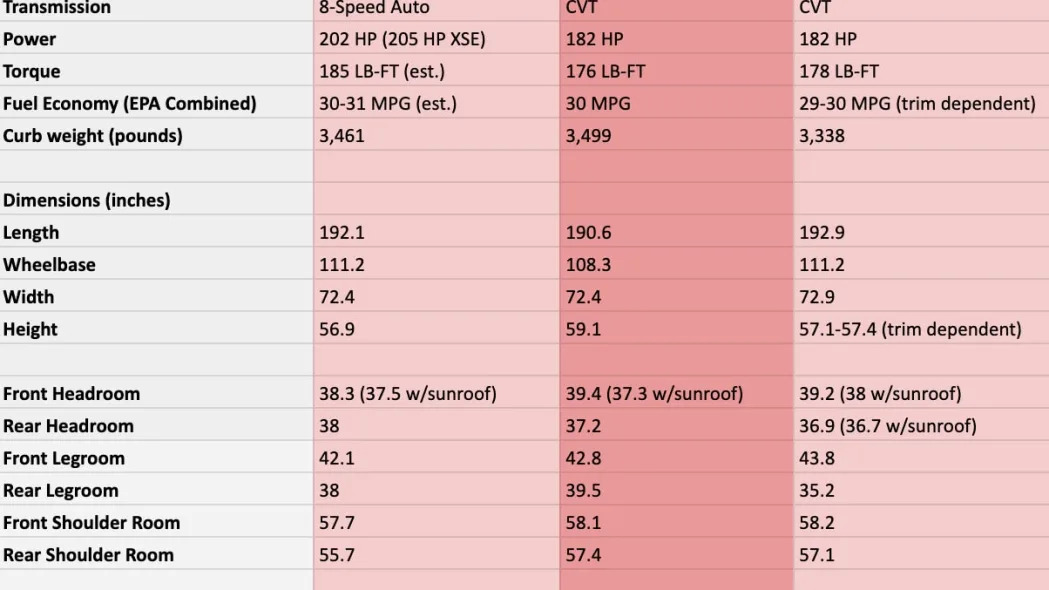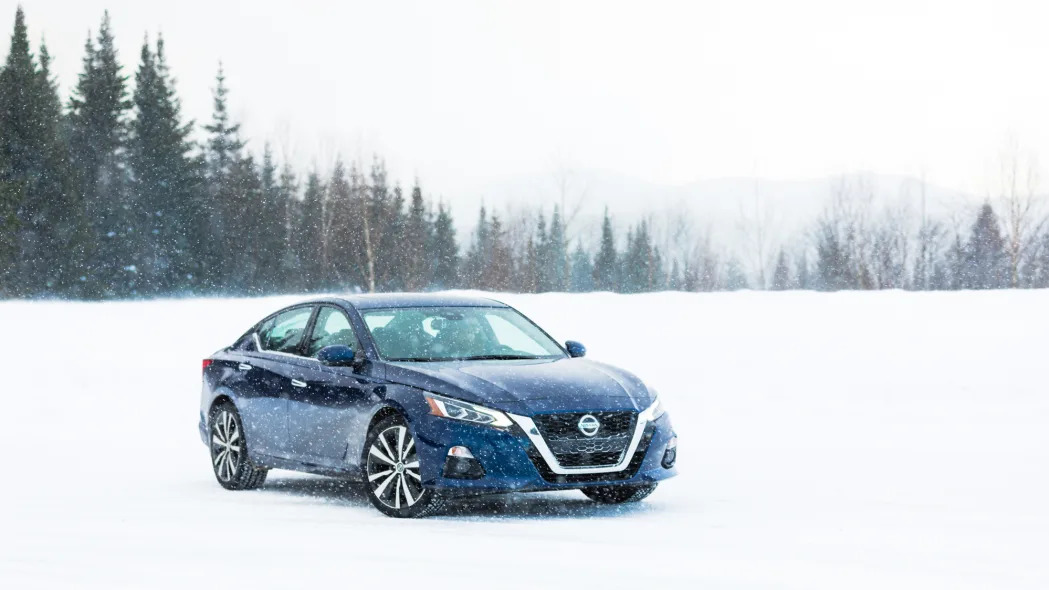Just as crossovers have become the dominant body style in the car market, the all-wheel drive they frequently feature has become more popular. In fact, all-wheel drive is so popular that automakers are increasingly putting it in traditional cars. The latest car to add driven wheels is the 2021 Toyota Camry. It will offer all-wheel drive on most of its trim levels, though only with the four-cylinder engine. It isn't alone in this market, though. So we've compiled the Camry's specifications, along with those of a couple of its competitors for comparison.
For the purposes of this analysis, we're sticking with the AWD veteran 2020 Subaru Legacy equipped with a naturally aspirated 2.5-liter engine and the relative newcomer 2020 Nissan Altima. Both are similar in pricing and power to Camry. We've skipped the turbocharged Legacy and the turbocharged Ford Fusion with all-wheel drive as both have higher base prices and significantly more power.
We'll take a look at these three sedans engine output, fuel economy, pricing and space. Below is a chart with all the raw numbers, and below that is more in-depth discussion of the cars.
Performance and Fuel Economy
These sedans are very closely matched, but one area where a clear winner emerges is in output. The Camry has a solid 21 horsepower and roughly 10 pound-feet of torque over the Subaru and Nissan. This, despite all of the engines having the same displacement. That power should make it quicker than the approximately 50-pound-heavier Subaru, though the Nissan Altima may stay with it thanks to its curb weight being about 100 pounds less than the Toyota. Also worth noting is that only the Toyota offers a traditional automatic transmission, whereas the Subaru and Nissan rely on CVTs. Subaru and Nissan have both dramatically improved their CVTs to the point they're quite unobtrusive, but if you strongly prefer the feel of softly shifting gears, the Toyota is your choice. In our experience, all three of these sedans are pleasant to drive with suspension and handling clearly tuned in favor of comfort over quickness.
Fuel economy is close to a dead heat. Toyota hasn't announced official fuel economy numbers for the all-wheel-drive model, but we can estimate that, as with most all-wheel-drive variants, mileage will be slightly lower than normal models. We're betting it will only about 1 mpg worse than front-drive variants. That puts it in the same 29 to 30 mpg overall range as the Subaru and Nissan. Looking closer at fuel economy, the Altima gets 35 to 36 mpg on the highway depending on trim, meaning some versions just beat out the Legacy's 35 mpg highway rating. The Subaru does a little better in town with a 27 mpg rating versus the Altima's best of 26 mpg in the city. We'll have to wait for Toyota to release its full EPA numbers to get a good idea of how the Camry compares in those more specific areas.
Interior and Exterior
Size-wise, these sedans are again close. The Camry and Altima are nearly identical, in fact, with the same wheelbase, an overall length differing by 0.8 inch and a height difference of less than that. The Subaru is shorter than the others by a 2 to 3 inches in overall length and wheelbase, and is about 2 inches taller than the others. Its width is identical to the Camry, though, and only half an inch narrower than the Nissan.
With exterior dimensions so similar, it's no surprise the cars are close inside, too. The Nissan Altima is the most generous with front passenger space, particularly with leg room. But the Altima is also the stingiest in rear seat accommodations with the sole exception of shoulder room. The Altima ekes out a narrow 0.3-cubic-foot win on trunk space, but as we recently discovered in our Legacy luggage test, the numbers don't tell the whole story.
As for design, the Camry is the most stylish with its curvy dash. The Legacy is more conventional, but its screen real estate is attention-grabbing, whether it's a pair of 7-inch displays or the single 11.6-inch screen found in most trim levels. The Nissan Altima's interior is a bit plain in comparison, but the low dash height is pleasant for making the cabin feel airy.
Pricing, Trims and Features
Though Toyota hasn't announced pricing for the all-wheel-drive Camry, we know the company will offer it as a standalone option on LE trims and up, skipping the base L trim. With that, we know it will cost more than the front-drive LE's base price of $25,795. The Nissan does offer all-wheel drive on every trim starting with the base S, and excluding only the turbocharged variant. But that base all-wheel-drive Altima has the highest (for now) price tag of $26,375. This means the Subaru Legacy, which comes standard with all-wheel drive on all trims, has a significant price advantage over the Toyota and the Nissan. The Subaru starts at just $23,645, which will be a about $3,000 less than the other two sedans.
Looking at standard equipment, these cars are similar but with some small differences. All three sedans have standard Apple CarPlay and Android Auto compatibility. The base Toyota and Subaru also have more driver assists standard such as adaptive cruise control, automatic emergency braking and lane-departure warning and assistance. On the convenience front, the Nissan Altima comes standard with remote start as well as proximity entry and push-button start.










Sign in to post
Please sign in to leave a comment.
Continue